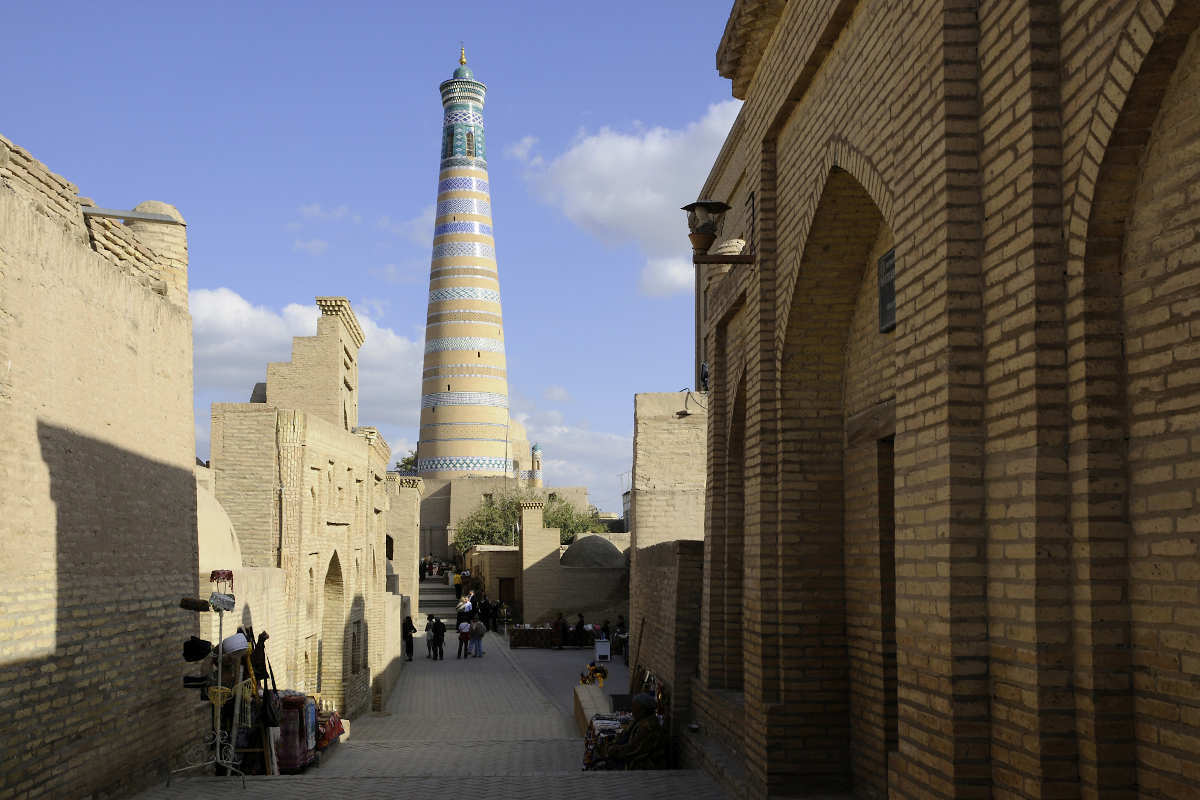Khiva - Islam Khoja Minaret

The Islam Khoja Minaret in Khiva – a symbol of architectural mastery and spiritual renewal
The Islam Khoja Minaret rises as a striking landmark above the silhouette of Khiva and is inextricably linked to the historical, cultural and political heritage of the late Khanate. It was built in 1908 under the aegis of Chief Vizier Islam Khoja; the entire building complex, including the madrasah and minaret, was completed in 1910. The name of this complex not only commemorates the person who commissioned it, but also one of the most visionary personalities of the early 20th century in Central Asia – a man who dedicated himself to change with courage, education and strategic vision and paid for it with his life.
Architecture between tradition and modernity
With a height of 56.6 metres and a base diameter of 9.5 metres, the Islam Khoja Minaret is the tallest minaret in Khiva and towers above all the buildings within the walled old town of Ichan Qal’a. The slender silhouette, which tapers elegantly towards the top, is modelled on the architectural ideals of the 14th century and makes particular reference to the minarets of Kunya-Urgench, one of the cultural cradles of medieval Khorezm.
The minaret is not only a religious building, but also a masterpiece of late classical Central Asian architecture. It combines rustic, unglazed brickwork with decorative zones of glazed ceramic tiles in shades of turquoise and sky blue. These bands structure the shaft horizontally, giving it a visual rhythm and emphasising its vertical dynamism. The brick body of the minaret rests on a solid foundation that takes into account the clay-sandy terrain of Khiva. The minaret was originally also designed as a lookout tower from which one could enjoy a sweeping view over the roofs of the old town, the oasis landscape of Khorezm and the desert beyond.
The adjoining building of the Medrese Islam Khoja is of a two-storey type with a traditional courtyard layout. In contrast to older madrasas, which were primarily focused on theological studies, this school was intended to be a centre for modern science and world knowledge. Its sober but clear structure and the targeted use of colour and ornamentation reflect both the aesthetic and ideological aspirations of its founder.
Islam Khoja – a reformer in a time of upheaval
Islam Khoja, the minaret’s namesake, was not only chief vizier at the court of the Khan of Khiva, but also father-in-law of the ruling Khan Isfandiyar. As one of the most educated men of his time, he had repeatedly visited the Russian Empire, including the capital St. Petersburg, and was very familiar with the economic, political and social developments of his era. At a time when the khanate was increasingly under Russian influence, Islam Khoja recognised that merely adhering to traditional structures would mean the downfall of the country.
He advocated a cautious but comprehensive reform of the state and social order. On his initiative, numerous modernisation projects were launched: a cotton ginning factory, a state hospital, a pharmacy and a post and telegraph office – facilities that were previously unknown in the Khanate of Khiva. Particularly noteworthy is his founding of the first secular school based on the European model, in which maths, chemistry, physics and geography were taught alongside Islamic subjects – a revolutionary step that opened up new educational paths for many young people.
Islam Khoja also campaigned for the planning and construction of a railway line that would connect the khanate more closely with Russia. His goal was the economic opening and infrastructural integration of Khorezm into the rapidly developing Eurasian region.
Intrigue, opposition and a tragic end
Despite his merits and successes, Islam Khoja was a lonely reformer in the midst of a conservative environment. The religious clergy and traditionalist nobility viewed his policies with deep suspicion and saw his course as a threat to the existing balance of power. In particular, his attempts to give the education system a secular foundation met with fierce resistance.
The conservative forces at court finally began to turn Khan Isfandiyar against his own father-in-law. They fuelled fears that Islam Khoja wanted to usurp power in the state or subject the khanate to foreign influence. Intrigues, rumours and targeted slander culminated in a political murder: one night, Islam Khoja was attacked in his carriage on the way home and brutally stabbed to death by several men. Despite his high position, there was no serious investigation – the khan remained silent and his vizier’s work of reform remained unfinished.
Symbolism and significance to this day
The Islam Khoja Minaret is not only an architectural masterpiece, but also a silent witness to the intellectual and political tensions in the late Khanate of Khiva. It marks the threshold between tradition and modernity, between medieval culture and the dawn of a new era. The combination of slender vertical lines and refined ornamentation makes it a visual focal point of the city, visible from almost every corner of Ichan Qal’as.
In the context of the city’s spatial organisation, the minaret stands in close proximity to other important monuments such as the Juma Mosque, the Tash-Hauli Palace and the Palvan-Darwaza Gate. Together with the madrasa, it forms an architectural ensemble that embodies both religious and secular education – a concept that has rarely been realised with such clarity in Central Asia.
Today, the Islam Khoja Minaret is one of the most important sights in Uzbekistan and is part of the UNESCO World Heritage Site of Khiva’s historic centre. It attracts thousands of visitors every year who not only want to admire its beauty, but also learn about the dramatic historical context of its creation. At a time when cultural identity and historical continuity are coming back into focus, the minaret is gaining a new, timeless relevance as a symbol of civilisational awakening and educational reform.
